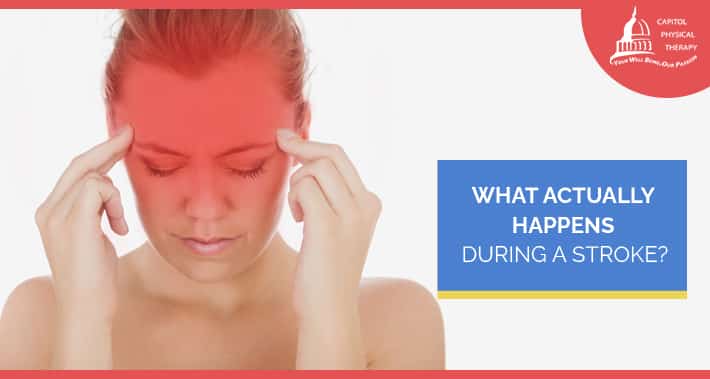
Have you or a loved one recently suffered a stroke?
You’re certainly not alone.
Approximately 800,000 people in the United States suffer a stroke every year.
Strokes are serious, life threatening conditions that require immediate treatment and rehabilitation in order to help restore lost functioning and reduce side effects.
Physical therapy after a stroke is an essential part of this rehabilitation process.
Today, we take a closer look at strokes – particularly, what’s actually happening when you experience one.
Let’s get started.
What Is A Stroke?
A stroke is a neurological condition that occurs due to insufficient blood flow to a part of the brain.
A stroke may occur for one of two reasons.
Firstly, a stroke can be caused by a blood clot blocking an artery in your brain.
Secondly, a ruptured blood vessel in your brain may also result in a stroke.
We’ll get into more detail on each of those later.
In both instances, however, the result is a lack of oxygen to your brain.
When your brain doesn’t have enough oxygen, your brain cells begin to die.
This can cause either temporary or permanent brain damage, depending on how serious the stroke is.
The symptoms of a stroke may vary, and include:
- Paralysis on one side of your body
- Arm, face, or leg numbness
- Slurred speech, trouble speaking, or trouble understanding speech
- A sudden severe headache or dizziness
- Confusion
- Blurred, blackened, or double vision
- Loss of balance and trouble walking
RELATED: How To Recognize A Stroke (And Prevent A Stroke From Happening)
What Happens During An Ischemic Stroke?
During an ischemic stroke, the flow of blood to your brain is blocked due to a blood clot.
A blood clot happens when your blood thickens, becoming semisolid inside your arteries.
The blood clot can either be an embolus or thrombus.
An embolus blood clot is one that travels from another part of your body.
On the other hand, a thrombus blood clot will have formed inside of an artery that supplies blood to your brain.
Blood clots themselves might be caused by a number of different conditions, including:
- Atherosclerosis
- Elevated cholesterol levels
- Certain medications
- COVID-19
- Deep vein thrombosis
- Heart disease
- Smoking
- Obesity
If treated quickly enough, medications can be useful in dissolving the blood clot and preventing severe, permanent brain damage.
For this reason, if you suspect you or a loved one is having a stroke, it’s important to get to an emergency hospital right away and note the time the symptoms started.
Ischemic strokes are the most common type of strokes, accounting for 87% of all cases.
What Happens During A Hemorrhagic Stroke?
As the name implies, a hemorrhagic stroke occurs when a blood vessel in your brain leaks, or hemorrhages, due to a weakness in the vessel wall.
The leaked blood flow surrounds your brain and creates pressure, which in turn damages brain cells and tissues.
Hemorrhagic strokes are much rarer than ischemic strokes, accounting for only 13% of all cases.
However, they are much more deadly and are responsible for 40% of all stroke deaths.
What Are The Effects Of A Stroke
The effects of a stroke may vary depending on which area of your brain was deprived of oxygen, and for how long.
General stroke effects include loss of memory, movement, or speech.
The size of the stroke can also determine the type of effects experienced.
For instance, a small stroke may only cause minor effects, such as temporary limb weakness.
On the other hand, a serious stroke may cause permanent paralysis on one side of your body, as well as significant speech and memory problems.
Fortunately the brain, just like muscles and bones, can heal itself.
The healing process for the brain can take about a year and takes more physical therapy than these other injuries.
Outcomes can vary though as some people recover quickly with very little side effects, while others have some form of permanent disability.
How Can Physical Therapy For Stroke Recovery Help?
Since a stroke causes an interruption in the connection between your brain and body, physical therapy is an essential part of the rehabilitation process after a stroke.
In fact, your physical therapist can provide you with support during all stages of your recovery.
As soon as 24 hours after a stroke, your physical therapist can help stimulate your affected nerves and muscles to maintain circulation, reduce stiffness or contractures, and prevent pressure sores or blood clots.
Further into your recovery, your physical therapist will help you learn how to reestablish your brain body connection for moving in bed, getting up from a chair, car transfers, floor transfers, walking with or without a cane or walker, and getting back to the hobbies you enjoy.
A physical therapist can also help you get the equipment you need for home if any of these activities are too difficult to safely perform as you work towards independence.
A physical therapist can also get you connected to adaptive sports teams and support groups as you are learning to adjust to this new diagnosis.
Book Your Appointment With Capitol Physical Therapy Today
Are you interested in learning more about the benefits of physical therapy for stroke recovery?
At our physical therapy clinics, we pride ourselves on our professionalism and quality of treatment.
Don’t hesitate to contact us to find out about the types of services that we offer.
Book your appointment with Capitol Physical Therapy today to find out more.
1331 H St NW #200,
Washington, DC 20005
- https://g.page/capitolptdc
9560 Pennsylvania Ave. # 202,
Upper Marlboro, MD 20772
- https://goo.gl/maps/zjL4NnnuThRhrcS86
Capitol Physical Therapy offers orthopedic and other pain related solutions, with our versitile team of physical therapists in Washington, DC